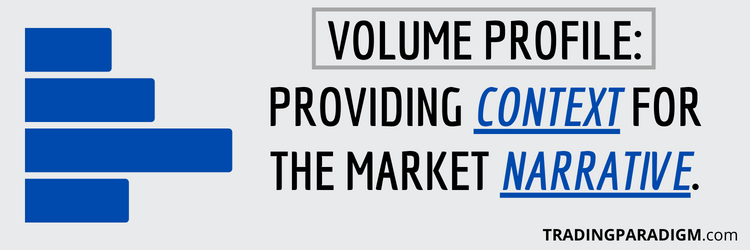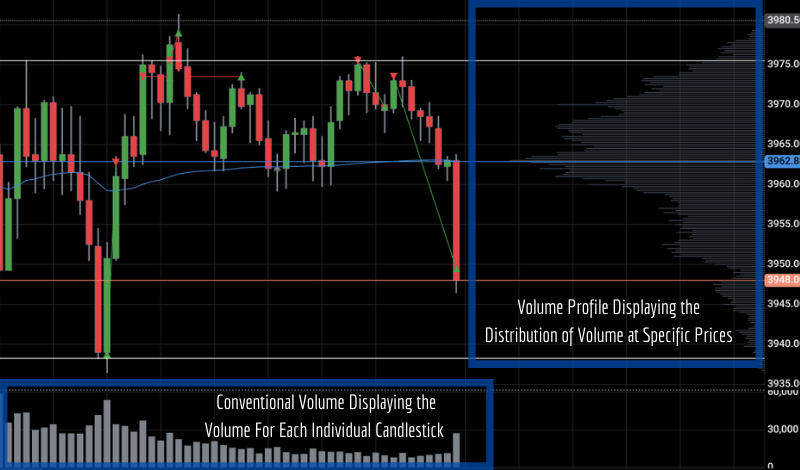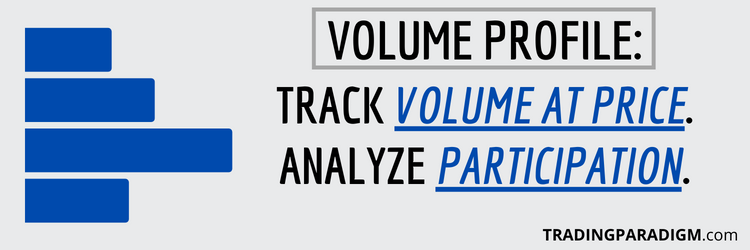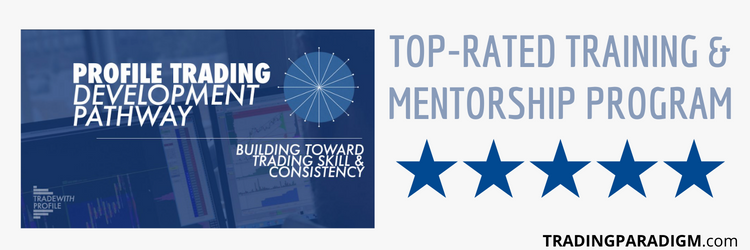What Critical Information Does Volume Profile Tell You as a Trader?
Most people who talk about volume profile and/or market profile jump too quickly into the typical jargon – immediately firing off terms like opening range, initial balance, point of control, value area highs/lows, day types, opening types, and more.

While these terms/concepts are important to understand in order to effectively trade based on volume profile analysis, it skips right over the critical explanation of what volume profile really tells you from a core foundational level.
In essence, volume profile is a histogram that displays participation at specific prices. It’s an in-depth visualization of where market participants are showing interest (or lack of interest). It exposes the “quality” of price with a visually appealing graphic.
It’s a unique (and more powerful) way to organize and interpret participation. Most traders, for example, only view volume at the bottom of their charts on a candle-by-candle basis – and don’t really understand what’s going on inside those candles.
Which prices are most important? Where are buyers and sellers the most and least willing to come together and do business? Which prices are experiencing acceptance (high participation) or rejection (low participation)?

These are some of the nuances of the market auction process that most retail traders simply don’t consider or understand.
Volume Profile Tells You Where Market Participants Are Willing to Get Involved:
Saying that volume profile “tracks participation” might not sound all that exciting or special, but it’s extremely significant.
When you can clearly see where market participants are willing and not willing to get involved, you can generate high-quality trade ideas/plans based on that information. I would argue that no other indicator or charting study is anywhere near as meaningful.
Back when pit trading was relevant, traders relied heavily on sound to tell them when other market participants were willing and not willing to get involved. So physically being in the pit provided a massive competitive advantage over the masses.
Now that electronic screen trading has far surpassed pit trading, it’s a slightly different experience. The sounds of the pit are no longer present, so sight (through the lens of a powerful graphic like volume profile) has become even more important than ever.
Seeing a low volume node on volume profile chart, for example, is extremely meaningful because it’s a level that the market is rejecting. So if/when price reaches that level again, just imagine the pit most likely getting quiet due to disinterest/low participation.
Physically being in the pit had its perks, but similar information can be gleaned through a graphic like the volume profile.
2 Top-Rated Volume Profile Coaches/Mentors – Josh Schuler & Aaron Korbs:
For in-depth training and mentorship around volume profile, I highly recommend Josh Schuler and Aaron Korbs.
Josh Schuler is the founder of Trade With Profile – which offers the Profile Trading Development Pathway program. And Aaron Korbs is the founder of Tradacc – which offers 2 main courses/programs: Volume Profile Formula (beginner) & Profile Method (advanced).
WHAT IS TRADE WITH PROFILE?HELPFUL RESOURCES:
|
WHAT IS TRADACC (TRADING ACCELERATOR)?HELPFUL RESOURCES: |
With this TradingParadigm website, my overarching goal is to point developing traders in the right direction in terms of legitimate edge development – and these 2 programs are easily some of the best available online in that regard (and I’ve been through dozens).
I currently have Trade With Profile listed as my #1 advanced training program and Tradacc listed as my #1 next-level mentorship program. But it’s really just splitting hairs. These are both incredible training/mentorship programs for serious traders.
I’ll probably publish an article/video breaking down the similarities and differences between the two at some point in the near future. But it really comes down to personal preference. Which mentor/coach resonates with you more – Josh Schuler or Aaron Korbs.
Overall, I think Trade With Profile offers the best overall value, but both Trade With Profile and Tradacc are well worth pursuing.
Conclusion – The Market is Telling a Story and Volume Profile Provides the Narrative:
The mistake that most retail traders make is getting enamored by price; they’re constantly chasing it up and down without any real understanding of the auction process. But price is merely an advertising mechanism. It’s virtually meaningless without context.
A great analogy for this way of trading (by chasing price) would be like trying to play soccer, baseball, basketball, football, or any other ball sport without being able to see the other players on the field/court. All you can see is the ball.
|Acquire X-Ray Market Vision With Expert-Level Training & Mentorship|
|Uncover the Most Effective Trading Indicators Available – Top 2 on My Charts|
But the positioning and posture of the other players provides important context for how you personally should act. Without this context, you’re left chasing the ball around with an extremely limited understanding as to why it’s moving from one spot to the next.
Yet this is exactly how most individuals behave within the market environment. They try to implement a one-dimensional, price-obsessed approach without regard to value (all 3 elements of price, time, and volume). They disregard the context/narrative.
But the market is always telling a story. It’s laying out the plot (context) – and it’s your job as a trader to come up with the most likely “endings” (hypos) and build a risk process around those circumstances (plans with asymmetric risk-reward).
To me, trading without volume profile is like trading blind. In its absence, market movement is extremely chaotic/confusing.
Written by Matt Thomas (@MattThomasTP)
Related Pages:
- What is Volume Profile – Trading With Volume Profile
- What is Volume Profile Formula and Profile Method?
- Tradacc Review (Trading Accelerator) – What is Tradacc.com?
- Volume Profile Formula Review – What is Volume Profile Formula?
- 3 Free Ways to Learn From Josh Schuler at Trade With Profile






This is a very informative article on volume profile trading and what exactly it tells you. I appreciate you outlining the overall meaning of the volume profile and how this relates to the larger trading strategy as a whole. I have found that typical introductions to this topic are handled precisely as you have stated, skipping the real meanings for industry jargon like opening range, initial balance, point of control, value area highs/lows, day types, opening types, etc. which is just gibberish to the uninitiated.
I love your analogy how trading without reference to other traders is like playing a team sport, only interacting with the ball and not the other players. I value your opinion and find your analysis easy to understand. Is volume profile trading a difficult game to break into or are there opportunities for beginners looking to get in?
Hi Joseph – great comments & questions. Thanks for sharing.
Generally speaking, trading is quite easy to “break into” these days. Pretty much anybody can open up a brokerage account or pursue a prop firm tryout and immediately start trading. There are virtually no barriers to entry – which is both good and bad. One one hand, it presents an incredible opportunity for individuals to step right into an environment with unlimited upside potential. But on the other hand, it’s dangerous for individuals who don’t take the education/training process seriously. Because there’s a big difference between merely being a market participant randomly/impulsively pushing buttons and being a legitimately competent, skilled, and self-sufficient trader taking strategic bets (with positive expected value) over-and-over again with a high degree of discipline. There are some amazing training programs out there for developing a strong technical edge through profile trading. But I also want to mention the free resources offered here at TradingParadigm to help build a strong foundation first and understand what being a real trader truly entails (without the gimmicks, lifestyle marketing, and other nonsense that’s so prevalent in the industry).
Thanks for an interesting read into volume profile trading.
I’m curious to read about the significance of visual acquity for trading now that the pit has been removed. Is there another means that technology has enabled for those who may be visually impaired, wanting to be successful in the world of trading?
I liked your sporting analogy. I haven’t heard of this form of trading, but this certainly makes sense to understand the volume profile and then analyze from the data being studied accordingly. I also liked how you made just two, great recommendations for where to find this type of training and not some ridiculous amount of options.
Hi Dale – thanks for sharing your thoughts.
Now that the vast majority of trading has transitioned out of physical pits onto screens – sight is an extremely critical component of trading. There’s a tool that I’ve heard of called TickStrike that converts order flow data into sound, but going off that alone would be extremely difficult to do. It’s something that should still probably be paired with visual charts. Unfortunately, I’m not so sure trading is a realistic option for individuals who can’t rely on sight to view/analyze charts.
Hi Matt, I love how informative your site is on trading. I’ve actually been looking into various market trading strategies recently and wanted to maybe give day trading a go. But to be honest, I have no idea where to start as a beginner. The Trade With Profile course looks like a great place to get started as a trader, but I was wondering if you have other resources to help beginners get started?
Hi Kevin – great question.
I always recommend beginners start with my free Trading Success Framework course in order to understand what trading truly entails from a foundational perspective. After going through that – if you’re serious/committed to acquiring legitimate edge/skill and achieving a consistent, sustainable level of trading success, then I absolutely recommend Josh Schuler’s Pathway programs at Trade With Profile. He’s one of the most underrated trading mentors I’ve ever come across, but his programs are the real deal (and ridiculously underpriced). So if you’re looking for an incredible value in terms of trader training/mentorship, this is absolutely the way to go.
Here are some additional helpful resources:
– Free Futures Trading Education – Top 5 Educational Resources
– Best Futures Trading Indicators – The Top 2 on My Charts
– Best Futures Trading Mentors – 3 of the Best in the Industry
As a beginner, I found this article about volume profile trading and how it can be used to improve my trading results to be very informative, and it has given me a new perspective on markets.
I am still learning about the different aspects of trading. I have been focusing on learning about technical analysis and how to use indicators to identify trading opportunities, but now a lot of my energy and time will be put toward real-time market generated information as opposed to lagging indicators. I have hardly ventured into volume profile trading at this point, but I am interested in learning much more about it.
Hi Oliver – thanks for sharing your thoughts on volume profile as a beginner.
I personally used/tested all kinds of trading indicators and systems (moving averages, RSI, MACD, Fibonacci levels, Bollinger bands, etc.) in the first handful of years when I started trading – and none of those indicators really “clicked” for me like auction market theory and profiling (volume profile & market profile) did.
I’m not saying that other indicators aren’t useful in any way or don’t work, but I do believe profiling to be the best/strongest way to observe and analyze markets. I understand the appeal of conventional indicators because they make people feel like they understand markets, but I think it tends to give them a false sense of confidence. Just because some moving average line crosses another one is hardly a reason to buy or sell. People love basic buy/sell “triggers” like this, but tend to disregard legitimate market context. Volume profile, on the other hand, puts all of the focus on what truly matters – real-time volume and how market participants are behaving in regard to price vs. value. In my opinion, this is the most meaningful context there is – and no lines crossing or deviation bands or arbitrary levels based on some complex mathematical equation can match it.
Matt, Your site is very informative. You take the time to explain critical concepts and lay out a real path to trading success. That is a big issue for people who do not understand trading or the market. Thank You, keep up the good work and keep on informing us that is what makes us grow and prosper with valuable information and tools.
Hi Gail – I appreciate the kind words and I’m glad you’ve found this site helpful!
That’s precisely my goal with the Trading Success Framework course and every other resource that I share/recommend – to lay out the real path to trading success. A lot of beginners think they know what trading entails, but in reality – they don’t. The same thing happened to me when I first started. I thought I knew what I was doing, but I really had no clue – and it took me about five years to actually get on the right path and stop consistently losing money in the markets. Far too many people take the same time-consuming path of so-called “shortcuts” that I did (with guru alert services, newsletters, chat rooms, and all kinds of other nonsense), but it doesn’t have to be that way.
Knowing what I know now – if I had just focused on proper education, training, and mentorship right from the start – I would’ve saved thousands of dollars and years of time. It’s so easy to say in hindsight, but I’m convinced I could’ve become consistently profitable in about 6-12 months by spending $5-10K on legitimate training/mentorship. Instead, it took me five years and over $30,000 in trading losses and useless subscription fees (to the alert services, newsletters, and chat rooms I mentioned earlier). Hopefully, however, those who are serious about trading can learn from my personal missteps and avoid the same arduous path. I made it a lot harder, longer, and more expensive than it had to be.
The whole field of trading can be a very complex area, with many phrases and terminology that one needs to learn. I had heard about volume profile, but didn’t know what it meant and what was involved in it. Your comparison with pit trading, has made it easier to understand how meaningful and important volume profile is.
How easy is it to find the volume profile of a stock? Do you have a recommended tool that can be used for finding the volume profile? Thank you.
Thanks for sharing your thoughts on volume profile – and great question.
Setting up the volume profile is fairly simple to do in my opinion, but it all depends on the trading/charting platform you’re using. Some platforms don’t offer volume profile and others consider it an “advanced” charting study. For complete beginners looking for initial exposure to volume profile to see what it’s all about, I would recommend a platform like TradingView. It’s cost-friendly, easy to use, and probably the most popular charting platform amongst retail traders. I would also recommend pairing that with Aaron Korbs’ Volume Profile Formula introductory course in order to learn how to use volume profile correctly/effectively. Once you start building a high degree of competence and skill around volume profile, then I would recommend a more professional trading/charting platform like EdgeProX or Sierra Chart.